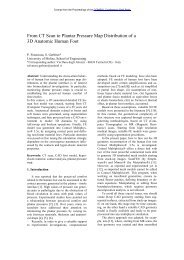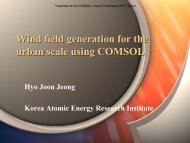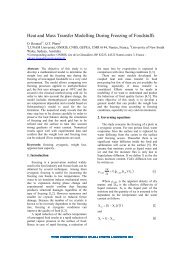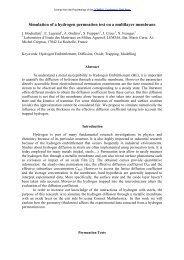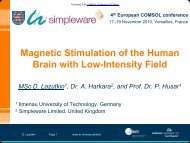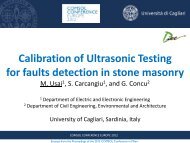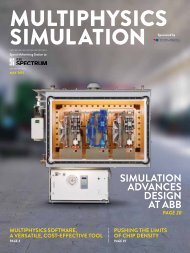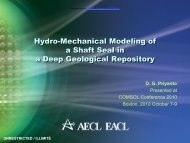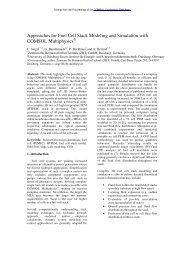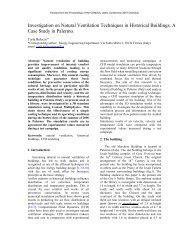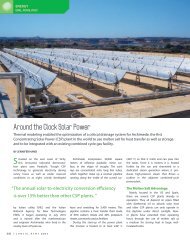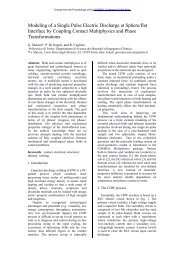Calculating Iron Losses Taking into Account Effects ... - COMSOL.com
Calculating Iron Losses Taking into Account Effects ... - COMSOL.com
Calculating Iron Losses Taking into Account Effects ... - COMSOL.com
You also want an ePaper? Increase the reach of your titles
YUMPU automatically turns print PDFs into web optimized ePapers that Google loves.
Excerpt from the Proceedings of the <strong>COMSOL</strong> Conference 2008 Hannover<br />
<strong>Calculating</strong> <strong>Iron</strong> <strong>Losses</strong> <strong>Taking</strong> <strong>into</strong> <strong>Account</strong> <strong>Effects</strong> of<br />
Manufacturing Processes<br />
P. Goes *1 , E.Hoferlin 1 and M. De Wulf 1<br />
1 OCAS N.V. – ArcelorMittal Research Gent<br />
*Corresponding author: John Kennedylaan 3 B9060 Zelzate, Belgium, Patrick.goes@arcelormittal.<strong>com</strong><br />
Abstract: Finite element modelling of electrical<br />
machines usually assumes uniform magnetic<br />
properties and loss behaviour throughout the<br />
steel laminations. It is well known that<br />
manufacturing processes, like the assembly of<br />
the machine, deteriorate the properties of the<br />
core material. Generally, the measured iron<br />
losses in the machine are higher than the losses<br />
obtained under standard conditions, the ratio<br />
being the so-called “building factor”. <strong>Taking</strong><br />
advantage of the multiphysics capabilities<br />
offered by Comsol Multiphysics, a model was<br />
developed with magnetic properties and losses<br />
being dependent on the mechanical stresses<br />
introduced during assembly of the machine.<br />
Keywords: iron losses, electrical machines,<br />
nonlinear material properties.<br />
1. Introduction<br />
These days, energy saving is the holy grail of<br />
engineering. Electrical machines transform<br />
mechanical energy <strong>into</strong> electrical energy or vice<br />
versa. Ferromagnetic materials are essential for<br />
concentrating the magnetic flux <strong>into</strong> the areas<br />
where it must generate forces. Electrical steels<br />
are developed to optimize their properties for use<br />
in laminated cores of electrical machines.<br />
The ideal electrical steel has:<br />
• High permeability: high B with low H,<br />
i.e. low currents and low copper losses.<br />
• High saturation polarization, for the<br />
same reasons.<br />
• Low electrical conductivity, for lower<br />
eddy currents in the core.<br />
Additional non-electromagnetical properties,<br />
such as stampability, are required.<br />
Manufacturing constraints make this ideal<br />
unattainable: trade-offs have to be made. Large<br />
efforts are being made in ArcelorMittal Research<br />
Gent to develop optimal electrical steel grades<br />
for specific applications. To assist customers in<br />
the selection and application of the ArcelorMittal<br />
electrical steels, finite element modelling studies<br />
are conducted as well.<br />
2. Energy losses in electrical steels<br />
2.1. Total loss P tot<br />
The methods for determining the loss properties<br />
are standardized. To measure core loss the<br />
material is mounted in an Epstein frame with a<br />
primary and a secondary winding around a test<br />
sample. An alternating current i(t) is generated in<br />
the primary winding, and the resultant secondary<br />
voltage v(t) is measured. The total energy loss<br />
per cycle is then obtained by integrating v(t) i(t)<br />
over one period T of the alternating current:<br />
P<br />
tot<br />
1<br />
=<br />
T<br />
T<br />
∫<br />
0<br />
v(<br />
t)<br />
i(<br />
t)<br />
dt<br />
It can be shown that this is equal to the area<br />
inside the BH-curve, which has units of teslaamperes<br />
per meter, which is identical to joule per<br />
cubic meter, or the total loss per volume unit.<br />
2.2. Hysteresis loss P hyst<br />
The hysteresis loss is the energy needed to make<br />
the material run through a magnetization cycle,<br />
when all induced eddy currents in the material,<br />
caused by the dynamics of the exciting field, are<br />
restricted to an absolute minimum. The<br />
corresponding loss per cycle is thus independent<br />
of the frequency f. The loss per time unit can be<br />
expressed as:<br />
P<br />
hyst<br />
= K<br />
2.3. Dynamic loss P dyn<br />
h<br />
B<br />
2<br />
max<br />
The dynamic loss is the difference of P tot and<br />
P hyst . This can be further separated <strong>into</strong> the<br />
classical Foucault loss (‘eddy current loss’) and<br />
excess loss. The equation for classical Foucault<br />
loss is:<br />
P c<br />
2 2<br />
= π σ d ( B<br />
max<br />
f<br />
f )<br />
2<br />
/ 6<br />
With σ the electrical conductivity and d the<br />
lamination thickness
3. Effect of mechanical stresses on the<br />
magnetic properties<br />
The dependence of magnetic properties on<br />
mechanical stress during elastic and plastic<br />
deformation can be evaluated by means of<br />
special constructed equipment, ([Permiakov<br />
2002]) consisting of a single sheet tester in<br />
which unidirectional tensile and <strong>com</strong>pressive<br />
loads can be applied to the specimen.<br />
3.1. Effect on the magnetization loop<br />
In general, the shape of the magnetization loops<br />
is changing during the application of stress, see<br />
Figure 1. The coercive field is increasing while<br />
the remanent induction and the permeability are<br />
decreasing.<br />
Figure 2. Variation of hysteresis loss as a<br />
function of mechanical stress.<br />
4. Application in the modelling of<br />
electrical machines<br />
Figure 1. Variation of magnetization loops under<br />
mechanical stress.<br />
Effect on the hysteresis losses<br />
Figure 2 depicts the hysteresis losses as a<br />
function of the tensile stress for the<br />
magnetization levels of 0.7, 1.0 and 1.2 Tesla<br />
and 50Hz sinusoidal magnetic flux.<br />
The stator of electrical machines is often<br />
assembled with the housing by means of pressor<br />
interference fitting. The housing inner<br />
diameter is slightly smaller than the stator’s<br />
outer diameter. The housing can then be<br />
mounted by heating it, sliding it over the stator,<br />
and allowing it to cool. The shrinking housing<br />
<strong>com</strong>presses the stator core, and, as mentioned in<br />
the preceding paragraph, these mechanical<br />
stresses deteriorate the magnetic properties of the<br />
electrical steel.<br />
We developed a model in Comsol multiphysics<br />
to quantify these effects.<br />
5. Solving for the interference fitting<br />
stresses<br />
The stresses occurring in the stator were<br />
calculated using the plane strain (smpn)<br />
application mode of the structural mechanics<br />
module, by including a thermal expansion load<br />
on the housing’s subdomain and letting it cool<br />
down from a reference strain temperature down<br />
to the ambient strain temperature.
2<br />
1.5<br />
s=0MPa<br />
s=20MPa<br />
s=40MPa<br />
B[T]<br />
1<br />
0.5<br />
Figure 3. von mises stress field<br />
0<br />
0 500 1000 1500<br />
H[A/m]<br />
Figure 4. B-H curve as function of stress<br />
2<br />
1.5<br />
B[T]<br />
1<br />
0.5<br />
Figure 4. von mises stress along a radius<br />
The line plot shows <strong>com</strong>pressive stresses inside<br />
the stator and tensile stresses in the housing, as<br />
expected.<br />
This stress state is subsequently used to modify<br />
the magnetic properties of the stator material.<br />
6. Modelling the magnetic properties<br />
For simulation purposes, the magnetization<br />
curve of electrical steel can be expressed as a<br />
function of just two parameters: the saturation<br />
polarization Js and the relative permeability µ r :<br />
2 J<br />
s<br />
π ( µ<br />
r<br />
−1)<br />
µ<br />
0<br />
H<br />
B( H ) = µ<br />
0<br />
H + arctg<br />
π<br />
2 J<br />
s<br />
The effect of the stress can be introduced by a<br />
correction factor:<br />
B H S B H K B<br />
( , ) = ( ,0) (1 + S)<br />
With the factor KS = 0.0035 determined by<br />
fitting to experimental data, stresses being<br />
expressed in MPa.<br />
S<br />
0<br />
0<br />
-20<br />
S[MPa]<br />
-40<br />
-60<br />
0<br />
200<br />
400<br />
H[A/m]<br />
As the emqa equation system needs H as a<br />
function of B, the above function has to be<br />
inversed.<br />
H[A/m]<br />
10000<br />
8000<br />
6000<br />
4000<br />
2000<br />
0<br />
0<br />
-20<br />
S[MPa]<br />
-40<br />
-60<br />
0<br />
This H(B,S) function is implemented in the<br />
Comsol model as a 2D interpolated table-lookup<br />
function.<br />
7. Solving for the magnetic flux density<br />
2D models of electrical machines are well suited<br />
for the perpendicular induction currents, vector<br />
potential (emqa) application mode: the currents<br />
are perpendicular to the modelling plane. This<br />
0.5<br />
B[T]<br />
1<br />
600<br />
1.5<br />
800<br />
1000<br />
2
implies that the magnetic field is present only in<br />
the modelling plane. Hence the magnetic vector<br />
potential has only one nonzero <strong>com</strong>ponent,<br />
perpendicular to the modelling plane. Maxwell’s<br />
equations simplify to a second-order scalar PDE<br />
with this magnetic potential <strong>com</strong>ponent Az as<br />
dependent variable.<br />
The constitutive relation to be used is<br />
H = f(|B|).e B , with e B the unit vector pointing in<br />
the direction of the B-field.<br />
The AC/DC module’s application mode supports<br />
nonlinear relationships between H and B.<br />
Here however, we need H = f(|B|,S).e B , and this<br />
requires some modification of the equation<br />
system:<br />
By default, the expressions for Hx_emqa and<br />
Hy_emqa refer to the HB interpolation function<br />
of the chosen material, e.g. mat1_HB:<br />
if(normB_emqa==0,nojac(pdiff(mat1_HB(norm<br />
B_emqa[1/T])[A/m],normB_emqa))*Bx_emqa,ma<br />
t1_HB(normB_emqa[1/T])[A/m]*Bx_emqa/normB<br />
_emqa)<br />
These expressions have to be modified in order<br />
to refer to the 2D interpolation function that<br />
describes the H = f(B,S), e.g. myHB2D:<br />
if(normB_emqa==0,nojac(pdiff(myHB2D(normB<br />
_emqa[1/T],mises_smpn[1/Pa])[A/m],normB_e<br />
mqa))*Bx_emqa,myHB2D(normB_emqa[1/T],mise<br />
s_smpn[1/Pa])[A/m]*Bx_emqa/normB_emqa)<br />
By first solving the smpn-physics for the stress<br />
and subsequently solving emqa, one finds the B-<br />
field degraded by the effects of the mechanical<br />
stresses.<br />
8. Postprocessing for the losses<br />
It is then a very simple matter to define the<br />
above expressions for the loss <strong>com</strong>ponents as<br />
subdomain expressions, to generate loss maps,<br />
and to integrate over <strong>com</strong>plete cycles of the<br />
machine to determine the overall core loss.<br />
9. Electrical steels material library<br />
A material library was developed, containing the<br />
ArcelorMittal electrical steels properties.<br />
10. Table 1: variables defined for electrical steels<br />
variable Font Description<br />
Js 2.1 [T] Saturation<br />
magnetic<br />
polarization<br />
mur0 8000 Relative<br />
permeability at<br />
H=0<br />
Kh 420<br />
[W*s*T^-<br />
3*m^-3]<br />
Hysteresis loss<br />
coefficient<br />
Ke 0.96 Excess loss<br />
coefficient<br />
d 0.2[mm] Lamination<br />
thickness<br />
sigma 3.2e6[S/m] Electric<br />
conductivity<br />
11. Conclusions<br />
Performing these calculations using typical<br />
electromagnetic FEA products requires splitting<br />
the geometry <strong>into</strong> discrete affected and nonaffected<br />
zones and assigning different material<br />
properties to each zone. As shown here, Comsol<br />
allows for continuous adaptation of the magnetic<br />
material properties, based on previous geometric<br />
and/or structural mechanical results.<br />
12. References<br />
1. G.Bertotti, General properties of power losses<br />
in soft ferromagnetic materials, IEEE Trans. On<br />
Magn., 24, p.621-630 (1988)<br />
2. V.Permiakov, A.Pulnikov, L.Dupré, M.De<br />
Wulf, J.Melkebeek, Magnetic properties of Fe-Si<br />
steel depending on <strong>com</strong>pressive and tensile<br />
stresses under sinusoidal and distorted<br />
excitations, J.Appl.Phys., 93, p.6689-6691<br />
(2003)


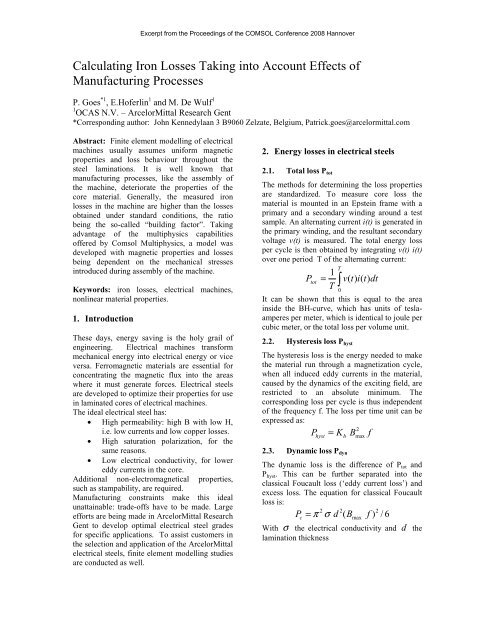

![[PDF] Comsol conference proceedings ... - COMSOL.com](https://img.yumpu.com/50379146/1/190x245/pdf-comsol-conference-proceedings-comsolcom.jpg?quality=85)
